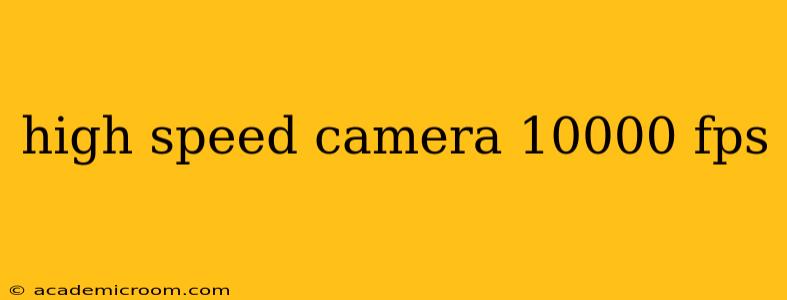High-speed cameras capable of capturing 10,000 frames per second (fps) and beyond have revolutionized numerous fields, offering unprecedented insights into incredibly fast-moving events. From scientific research to industrial quality control, these cameras provide a level of detail previously impossible to achieve. This article delves into the capabilities of 10,000 fps high-speed cameras, exploring their applications, key features, and considerations for choosing the right one.
What are the applications of high-speed cameras with 10,000 fps?
High-speed cameras operating at 10,000 fps and higher find applications across a vast range of disciplines. These include:
-
Scientific Research: Studying rapid phenomena like fluid dynamics, combustion processes, ballistic impacts, and material deformation. The high frame rate allows scientists to analyze these events with exceptional clarity, revealing subtle details that would be invisible to the naked eye or even slower cameras.
-
Sports Analysis: Analyzing athletic movements with unparalleled precision to improve technique and performance. Examples include golf swings, tennis serves, and the biomechanics of running.
-
Industrial Quality Control: Identifying defects in manufacturing processes, such as cracks or inconsistencies in materials, by examining high-speed operations like stamping, welding, or injection molding.
-
Automotive Testing: Crash testing and analyzing the behavior of vehicles and their components under extreme conditions. This data is critical for improving vehicle safety and design.
-
Medical Research: Studying rapid physiological processes, such as blood flow, nerve impulses, and the mechanics of surgical procedures.
What are the key features to consider when choosing a 10,000 fps high-speed camera?
Selecting the appropriate high-speed camera requires careful consideration of several key features:
-
Frame Rate: While 10,000 fps is a significant speed, the actual required frame rate depends on the application. Some applications may require even higher frame rates, while others might suffice with a lower rate.
-
Resolution: The resolution determines the level of detail captured. Higher resolution allows for more accurate analysis, but also increases data storage requirements and processing demands.
-
Sensor Size: Larger sensors generally provide better low-light performance and a shallower depth of field, while smaller sensors offer compactness and affordability.
-
Shutter Speed: The shutter speed determines the duration of each exposure. Fast shutter speeds are necessary for capturing extremely fast events, preventing motion blur.
-
Storage and Data Transfer: High-speed cameras generate massive amounts of data. Consider the storage capacity, data transfer speed, and compatibility with different storage media.
-
Lighting Requirements: Adequate lighting is essential for achieving high-quality images, especially at higher frame rates. The sensitivity of the camera sensor is a crucial factor here.
What is the difference between a 10,000 fps camera and a slower camera?
The primary difference lies in the ability to capture and resolve events that occur at extremely high speeds. A 10,000 fps camera can capture details invisible to slower cameras, enabling a deeper understanding of dynamic processes. This leads to more accurate analysis and the identification of subtle details that could significantly impact research, development, and quality control.
How much do high-speed cameras cost?
The cost of high-speed cameras varies considerably depending on the features, resolution, frame rate, and sensor size. Entry-level models might be available at several thousand dollars, while high-end systems capable of extremely high frame rates and resolutions can cost tens or even hundreds of thousands of dollars.
What are some examples of brands that produce high-speed cameras?
Several reputable brands produce high-speed cameras with 10,000 fps capability and beyond. Researching the specific models offered by these manufacturers is crucial to selecting the best camera for a given application. (Note: Specific brand mentions are omitted to avoid the appearance of endorsement and maintain neutrality.)
How do I choose the right high-speed camera for my needs?
Choosing the right high-speed camera involves carefully evaluating the specific requirements of your application. Consider the necessary frame rate, resolution, sensor size, shutter speed, and data storage needs. Consulting with experts in the field can provide valuable guidance in selecting the optimal system for your particular needs.
This information should provide a solid foundation for understanding the world of high-speed cameras operating at 10,000 fps and beyond. Remember to conduct thorough research and consult with specialists to ensure you choose the best camera for your specific application and budget.
